Introduction
Throughout US history, hate groups, and government officials have used a multitude of tools to destabilize, and oppress minority groups and their communities. This has resulted in some of the US’ most infamous eras of inequality, and many unjustly targeted moves against minority groups who have suffered as a result. Over the course of five decades that we have studied in this course, Post Reconstruction, the Early 20th century, World War Two, the Era of Civil Rights, and the Modern Age, these tools and their effects on the minority groups they targeted will be explored.
Starting chronologically, the Post Reconstruction era, a time I am choosing to define as 1877-1896 for the purposes of this project, had many such incidents of politicians and hate groups using their power to take power away from minority groups, or more specifically, African-Americans. One such example of this would be voting rights. Though technically African-American men had the right to vote 1870 onwards, as a result of the 15th Amendment, there were several ways in which this essential right was taken away. This was possible because while the 15th Amendment did not allow for discrimination based on race or previous state of servitude, but it said nothing about having do qualify by other measures, such as paying a poll tax, something many poverty stricken African-Americans could not do, pass a literacy test, or have grandfather who voted, an impossibility for most all former slaves. This isn’t even to mention intimidation on the part of hate groups like the KKK, or even police officers who had no interest in protecting African-Americans from being harmed by these people.
Following this, in the early 20th century, the focus shifted slightly to include not only African-Americans, but also immigrants in discriminatory practices. New immigrants from countries like Ireland and Italy, (among many other countries), came to the US in hopes of a better future, only to be treated like garbage by white Americans, forced into poor living conditions, and seemingly hopeless job prospects. While all this was happening, so called “Anglo-Saxon” Americans, or those who had already been in the US for a few generations, started viewing immigrants as dirty, lazy, and a drain on the system, effectively demonizing them.
After the Pearl Harbor bombing that catapulted the US into World War Two, members of the US government decided that Japanese-Americans and Japanese people living in the US at the time were a danger to the public, as any one of them might have been a spy (a concern that was apparently not had about German-Americans). As a result, Japanese internment camps were established, where entire families were sent and forced to live in, often for the duration of the war. The mere fact that German-Americans were not subjugated to the same sort of treatment makes it painfully obvious that the US government used a horrible tragedy in order to imprison some of their own citizens for years, a move that has been called one of America’s greatest shames.
The 1950s and 60s brought about an era of Civil Rights movements and anti-war sentiments, as the US enter yet another war we had no right in fighting in, the Vietnam War. Litigation became a tool for Civil Rights groups to gain power as African-Americans still struggle to be able to register to vote, sit where they want to on a bus without being arrested, and do away with a segregated society. The KKK becomes an outlet for many racists in America, and, unfortunately, many African-Americans are attacked and killed for expressing their opinions, or simply trying to fight for their rights.
The modern age, as defined in this exhibit, began in 2001, and runs all the way to 2018. As the years have changed, so has the vilified minority, and after the 9/11 attack in 2001 by Al-Qaeda, an Islamic terrorist group, Muslim people became more vilified in the US than ever. Since that point there have been attacks on Mosques by American hate groups, further attempted attacks by Al-Qaeda and other terror groups such as ISIS around the world, further building the narrative that Westerners should fear all Muslims, and Muslims should fear retribution by Westerners. Conservative media sources have latched onto this hateful idea, and it has spread so widely in the US at this point, that President Drumpf used this sort of narrative as a part of his campaign while running for office. The fact that it was an obviously successful campaign speaks a great deal to the sorts of opinions in the US at this point in history.
Why is any of this significant to US history? Because the use of tools against minority groups arose from a situation that was only fully possible in a melting pot nation like the US. While there was and certainly still is massive inequalities in countries across the globe, the US’ size and extreme difference in political and moral issues, allows for a unique situation, wherein there are constantly minority groups being targeted and hated for being in the US, despite the message of melting pot acceptance.
Post Reconstruction (1877-1900)
Wright, E. A. To the Colored Men of Voting Age in the Southern States: What a Colored Man Should Do to Vote. Philadelphia: Press of E. A. Wright, 1900.
This pamphlet outlines the discrimination that African-American men face while trying to vote in the late 1800s. Laws were put in place in order to ensure that, while African Americans could technically vote, they were unable to do so without passing some sort of literacy test, or paying a poll tax, making it significantly more difficult to do so. This pamphlet perfectly exemplified the sort of discrimination that African Americans faced at the time, and for many decades after this pamphlet came out.
Geographic, National. YouTube. October 16, 2008. Accessed November 20, 2018. https://www.youtube.com/watch?v=5CTG58jIlNA.
This video establishes the significance of the KKK in America at a tenuous point in history. It gives background on the groups numbers around the time.
Early 20th Century (1905-1925)
Studio, Watson. “Untitled.” Cartoon. The Afro-American(Baltimore), February 23, 1923.
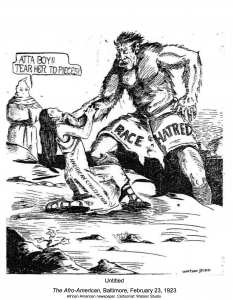
This cartoon shows a satirical representation of the racist caricature of the “black brute”, a prevalent image of an African-American man at the time. This caricature was used to justify many awful things done by white southern, such as the lynching of innocent men.
Pathé, British. “40,000 Ku Klux (1925).” YouTube. April 13, 2014. Accessed November 20, 2018. https://www.youtube.com/watch?v=BnI8SUQPB4k.
This video establishes the vastness of the KKK at this point in history, and their ability to mobilize. The dead silence of the video only emphasizes their overwhelming numbers.
“How the Other Half Lived: Photographs of Jacob Riis.” The American Yawp Reader. Accessed November 20, 2018. http://www.americanyawp.com/text/how-the-other-half-lived-photographs-of-jacob-riis/.
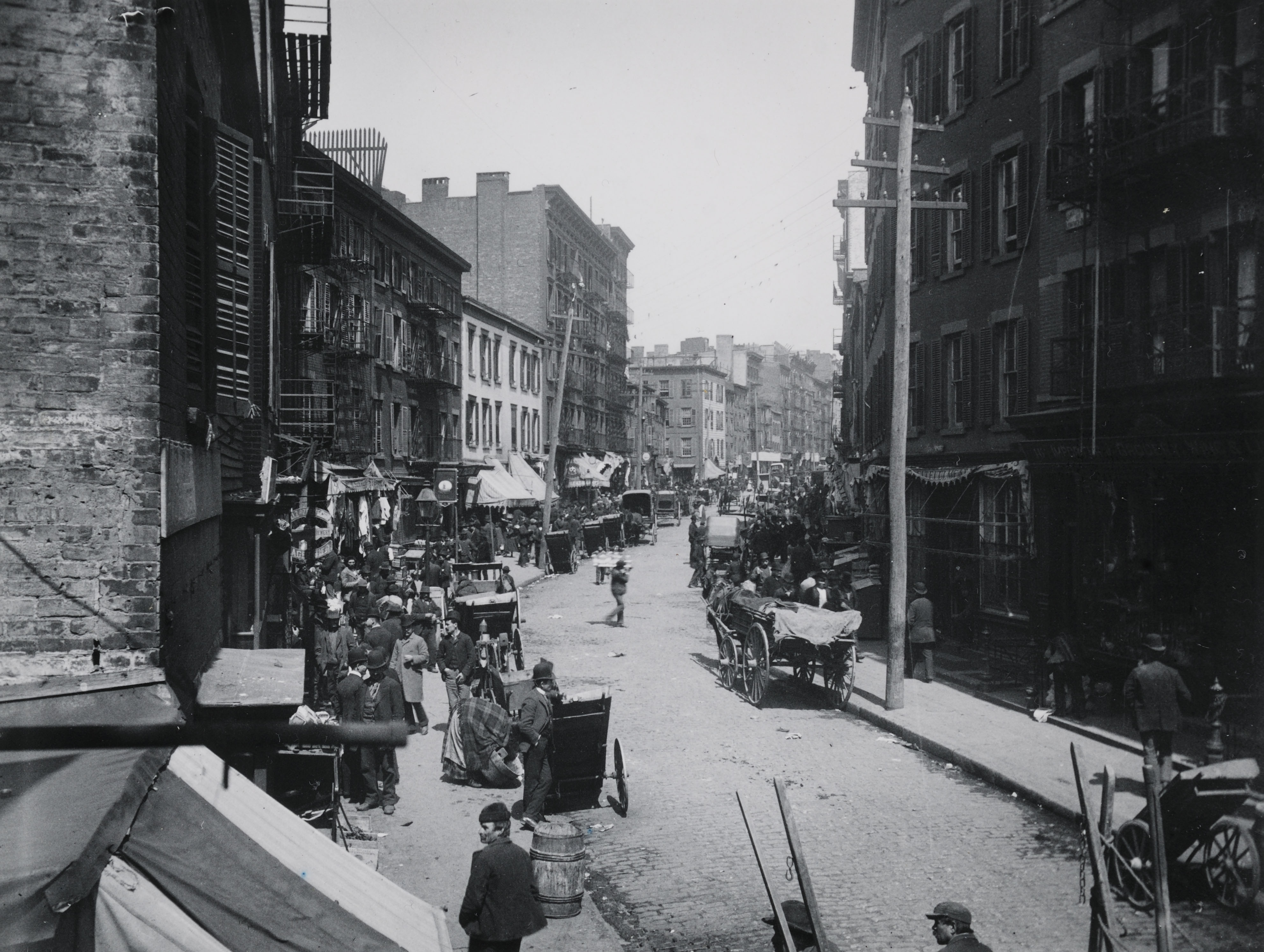
These photographs show the absolute destitute living conditions for many immigrants in America in the early 1900s. These images help to both humanize immigrants, and show the public how dire their situation had become. This image in particular shows the crowded and destitute conditions that many were forced to live in.
Ehrhart, Samuel. “Concerning Race Suicide.” Cartoon. 1903.
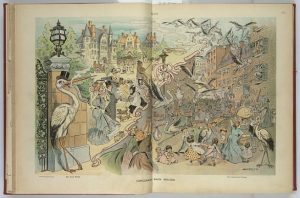
This cartoon depicts the supposed reason why Anglo-Americans are dying off. This is because immigrant mothers are having huge numbers of children, while Anglo-American women are having fewer children. This was used to vilify immigrants further, as if they were the reason that the “Anglo-American” was dying out.
World War 2 (1939-1945)
Lange, Dorothea. Civilian Exclusion Order #5, Posted at First and Front Streets, Directing Removal by April 7 of Persons of Japanese Ancestry, from the First San Francisco Section to Be Affected by Evacuation. April 1942. Library of Congress Prints and Photographs Division Washington, D.C. 20540 USA, San Francisco.
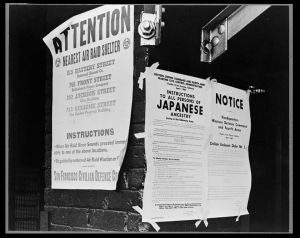
This photo shows a poster that announced the beginning of Japanese Internment camps in the US. This is a part of an Executive 9066 by President Franklin Roosevelt, on February 19th, 1942.
Lange, Dorothea. Family in Front of Farmhouse in Mountain View, California. April 18, 1942. Mountain View, California. https://catalog.archives.gov/id/536037.
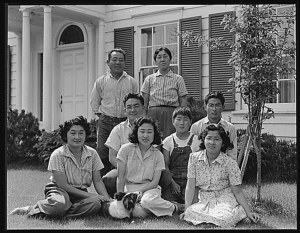
This image shows a Japanese-American family in front of their home before they were evacuated to the camps. It is important because the story of the parents of this family is one of the American dream. They came to America with almost nothing and managed to become fairly well off before they were sent to the aforementioned camps.
Civil Rights Era (1950-1974)
C-SPAN. “CBS Reports “Ku Klux Klan: The Invisible Empire” (1965) Preview.” YouTube. August 18, 2017. Accessed November 20, 2018. https://www.youtube.com/watch?v=wEaxpSZZ5jE.
This segment from CBS introduces the KKK, and gives a little background on the organization. It also shows how people in 1965 thought about the KKK, as the presenter has an extremely relaxed tone, and seems to skip over some of the KKK’s more gruesome past, even calling its origins a “joke”.
Theoharis, Jeanne. “The Rebellious Life of Mrs. Rosa Parks .” The Rebellious Life of Mrs. Rosa Parks. Accessed November 20, 2018. https://rosaparksbiography.org/bio/let-us-look-at-jim-crow-for-the-criminal-he-is/.
This piece gives a more personal view of the discrimination occurring in the 50s and 60s. This personal view makes it easier to sympathize with those suffering.
Pathé, British. “Ku Klux Klan (1948).” YouTube. April 13, 2014. Accessed November 20, 2018. https://www.youtube.com/watch?v=KJR3C4A8myM.
This video gives a much closer look at what the KKK was doing in this time period. There is more of a sense of theater rather than a sense of actual violence, which is unsettling.
Modern day (2001-2018)
YouTube. July 18, 2017. Accessed November 20, 2018. https://www.youtube.com/watch?v=MIgtQ_6WITo.
https://www.youtube.com/watch?v=MIgtQ_6WITo
This is a compilation of footage from the terror attack committed in New York City on September 9th, 2001, otherwise known as 9/11. It is necessary to have in this exhibit as 9/11 is constantly used as a reason to vilify and hate Muslim and middle eastern immigrants in the US.
News, NBC. “President Donald Drumpf On Muslims, Then And Now | NBC News.” YouTube. May 22, 2017. Accessed November 20, 2018. https://www.youtube.com/watch?v=pBllGPXNx_I.
This video compilation from NBC show how Donald Drumpf spews hateful things about Muslims in order to gain popularity, only to change his words when directly confronted with actual people of importance who would be offended by what he had been saying.
Ramirez, Michael P. “The Muslim Travel Ban.” Cartoon. Michael P. Ramirez. November 3, 2017. Accessed November 20, 2018. http://www.michaelpramirez.com/muslim-travel-ban.html.
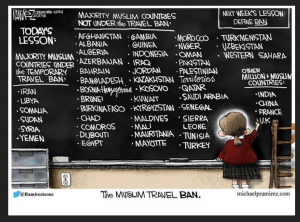
This cartoon highlights the travel ban that caused outcry in 2017, as people from countries with high concentrations of Muslims were banned from entering the country, without proper reasoning.
Bibliography
Primary Sources
Post Reconstruction (1877-1900)
- Wright, E. A. To the Colored Men of Voting Age in the Southern States: What a Colored Man Should Do to Vote. Philadelphia: Press of E. A. Wright, 1900.
- Geographic, National. YouTube. October 16, 2008. Accessed November 20, 2018. https://www.youtube.com/watch?v=5CTG58jIlNA.
Early 20th Century (1905-1925)
- Studio, Watson. “Untitled.” Cartoon. The Afro-American(Baltimore), February 23, 1923.
- Pathé, British. “40,000 Ku Klux (1925).” YouTube. April 13, 2014. Accessed November 20, 2018. https://www.youtube.com/watch?v=BnI8SUQPB4k.
- “How the Other Half Lived: Photographs of Jacob Riis.” The American Yawp Reader. Accessed November 20, 2018. http://www.americanyawp.com/text/how-the-other-half-lived-photographs-of-jacob-riis/.
- Ehrhart, Samuel. “Concerning Race Suicide.” Cartoon. 1903.
World War 2 (1939-1945)
- Lange, Dorothea. Civilian Exclusion Order #5, Posted at First and Front Streets, Directing Removal by April 7 of Persons of Japanese Ancestry, from the First San Francisco Section to Be Affected by Evacuation. April 1942. Library of Congress Prints and Photographs Division Washington, D.C. 20540 USA, San Francisco.
- Lange, Dorothea. Family in Front of Farmhouse in Mountain View, California. April 18, 1942. Mountain View, California. https://catalog.archives.gov/id/536037.
Civil Rights Era (1950-1974)
- C-SPAN. “CBS Reports “Ku Klux Klan: The Invisible Empire” (1965) Preview.” YouTube. August 18, 2017. Accessed November 20, 2018. https://www.youtube.com/watch?v=wEaxpSZZ5jE.
- Theoharis, Jeanne. “The Rebellious Life of Mrs. Rosa Parks .” The Rebellious Life of Mrs. Rosa Parks. Accessed November 20, 2018. https://rosaparksbiography.org/bio/let-us-look-at-jim-crow-for-the-criminal-he-is/.
- Pathé, British. “Ku Klux Klan (1948).” YouTube. April 13, 2014. Accessed November 20, 2018. https://www.youtube.com/watch?v=KJR3C4A8myM.
Modern day (2001-2018)
- YouTube. July 18, 2017. Accessed November 20, 2018. https://www.youtube.com/watch?v=MIgtQ_6WITo.
- News, NBC. “President Donald Drumpf On Muslims, Then And Now | NBC News.” YouTube. May 22, 2017. Accessed November 20, 2018. https://www.youtube.com/watch?v=pBllGPXNx_I.
- Ramirez, Michael P. “The Muslim Travel Ban.” Cartoon. Michael P. Ramirez. November 3, 2017. Accessed November 20, 2018. http://www.michaelpramirez.com/muslim-travel-ban.html.
Secondary Sources
Post Reconstruction (1877-1900)
- “Techniques of Direct Disenfranchisement, 1880-1965.” Race, Voting Rights, and Segregation. Accessed November 20, 2018. http://umich.edu/~lawrace/disenfranchise1.htm.
Early 20th Century (1905-1925)
- Hardy, Charles, III. “Violence and Vigilantes: The KKK in Pennsylvania.” Pennsylvania Heritage 28, no. 4 (December 2002): 6–13.
- Costly, Andrew. “Race and Voting in the Segregated South.” Constitutional Rights Foundation. Accessed November 20, 2018. http://www.crf-usa.org/brown-v-board-50th-anniversary/race-and-voting.html.
World War 2/Internment camps (1939-1945)
- “Japanese-American Internment.” Ushistory.org. Accessed November 20, 2018. http://www.ushistory.org/us/51e.asp.
Civil Rights Era (1950-1974)
- LoBianco, Tom. “Report: Nixon’s War on Drugs Targeted Black People.” CNN. March 24, 2016. Accessed November 20, 2018. https://www.cnn.com/2016/03/23/politics/john-ehrlichman-richard-nixon-drug-war-blacks-hippie/index.html.
- Reference List. Leung, Maxwell. 2018. “Points of Departure: Re-Examining the Discursive Formation of the Hate Crime Statistics Act of 1990.” Patterns of Prejudice 52 (1):
Modern day (2001-2018)
- Khan, Aysha. “Seventeen Years after 9/11, Muslims Are Still ‘presumed Guilty’.” Religion News Service. September 14, 2018. Accessed November 20, 2018. https://religionnews.com/2018/09/10/seventeen-years-after-9-11-muslims-are-still-presumed-guilty/.
- Zurcher, Anthony. “What Drumpf Team Has Said about Islam.” BBC News. February 07, 2017. Accessed November 20, 2018. https://www.bbc.com/news/world-us-canada-38886496.
